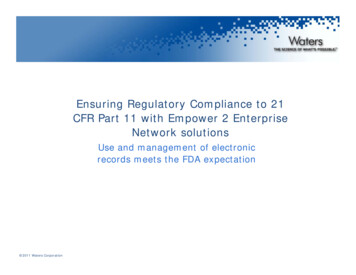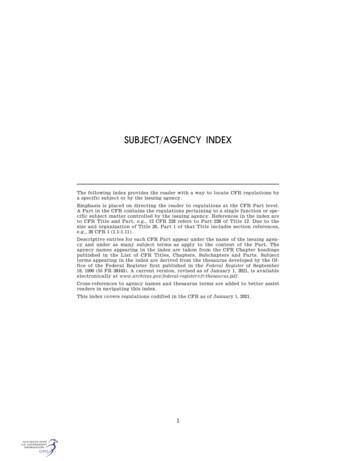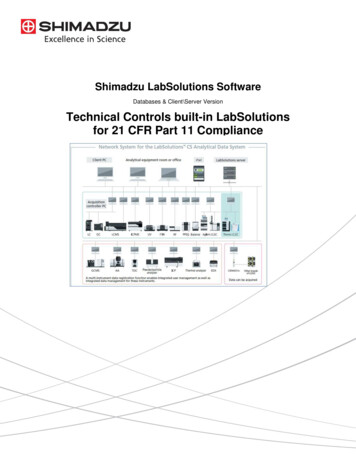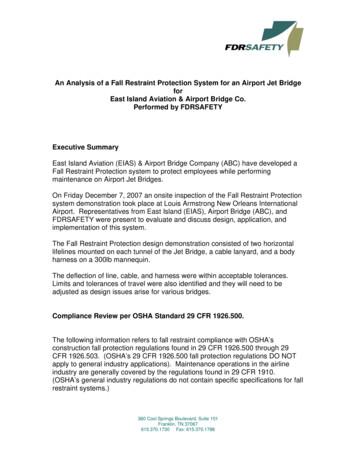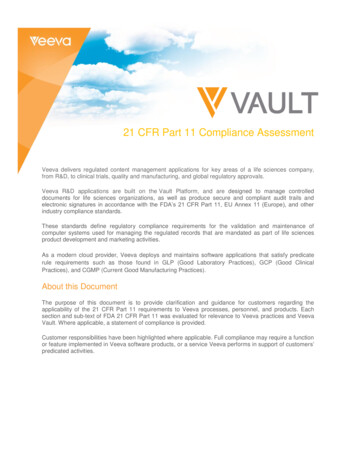
Transcription
21 CFR Part 11 Compliance AssessmentVeeva delivers regulated content management applications for key areas of a life sciences company,from R&D, to clinical trials, quality and manufacturing, and global regulatory approvals.Veeva R&D applications are built on the Vault Platform, and are designed to manage controlleddocuments for life sciences organizations, as well as produce secure and compliant audit trails andelectronic signatures in accordance with the FDA’s 21 CFR Part 11, EU Annex 11 (Europe), and otherindustry compliance standards.These standards define regulatory compliance requirements for the validation and maintenance ofcomputer systems used for managing the regulated records that are mandated as part of life sciencesproduct development and marketing activities.As a modern cloud provider, Veeva deploys and maintains software applications that satisfy predicaterule requirements such as those found in GLP (Good Laboratory Practices), GCP (Good ClinicalPractices), and CGMP (Current Good Manufacturing Practices).About this DocumentThe purpose of this document is to provide clarification and guidance for customers regarding theapplicability of the 21 CFR Part 11 requirements to Veeva processes, personnel, and products. Eachsection and sub-text of FDA 21 CFR Part 11 was evaluated for relevance to Veeva practices and VeevaVault. Where applicable, a statement of compliance is provided.Customer responsibilities have been highlighted where applicable. Full compliance may require a functionor feature implemented in Veeva software products, or a service Veeva performs in support of customers’predicated activities.
21 CFR Part 11 Compliance AssessmentAbout 21 CFR Part 11On March 20, 1997 (Federal Register Vol. 62 No 4), the Food and Drug Administration (FDA) published aset of regulations that define “the criteria under which the agency considers electronic records, electronicsignatures, and handwritten signatures executed to electronic records to be trustworthy, reliable, andgenerally equivalent to paper records and handwritten signatures executed on paper.”The regulation is divided into three subparts that cover:a) General Provisionsb) Electronic Recordsc) Electronic SignatureIn 2003, the FDA published guidance on the application of Part 11, indicating agency intent to enforce “allpredicate rule requirements, including predicate rule record and recordkeeping requirements,” but that“fewer records will be considered subject to part 11;” and further noted that Part 11 would be “interpretednarrowly.”The following controls were highlighted as critical: Limiting system access to authorized individuals. Use of operational system checks. Use of authority checks. Use of device checks. Determination that persons who develop, maintain, or use electronic systems have the education,training, and experience to perform their assigned tasks. Establishment of and adherence to written policies that hold individuals accountable for actionsinitiated under their electronic signatures. Appropriate controls over systems documentation. Controls for open systems corresponding to controls for closed systems bulleted above. Requirements related to electronic signatures. Indication of who (Veeva or Customer) must act, and the mechanism of action (behavior,procedural, or an application design element) that must be in place in order to satisfy theregulation.
21 CFR Part 11 Compliance AssessmentDescription of ControlsVeeva IT Controls & ProcessesCustomerPart 11 itySubpart B – Electronic Records§11.10 Controls for Closed Systems§11.10 Persons who use closed systems to create, modify, maintain, or transmit electronic records shall employ procedures and controls designed to ensure theauthenticity, integrity, and when appropriate, the confidentiality of electronic records, and to ensure that the signer cannot readily repudiate the signed record as notgenuine. Such procedures and controls shall include the VeevaValidation of systems to ensure accuracy,reliability, consistent intended performance,and the ability to discern invalid or alteredrecords.Veeva has implemented a comprehensive Computer Systems Validation(CSV) program codified in policy and further detailed in procedure. CSVdeliverables are reviewed and approved by the Veeva Quality Unit.—X—Customers are responsible for demonstrating that the system has beenconfigured to their business requirements and is fit for use. Thisdemonstration may come in the form of a PQ or UAT and must beperformed under the customer’s QMS.——XThe ability to generate and complete copiesof records in both human readable andelectronic form suitable for inspection,review, and copying by the agency.Veeva Vault provides system records in human readable form suitable forinspection, review, and copying by the agency. Configurable reports andexports permit review of records and associated metadata. In addition, anAPI is available for custom access to all stored records.X——Protection of records to enable theiraccurate and ready retrieval throughout therecords retention period.Veeva Vault's scalable architecture ensures all records (even archivedrecords) are retained and can be retrieved from the productionenvironment throughout the record retention period. No separate offsite orarchive storage is required.X——Veeva hosts and operates its software on servers located in secure datacenters. Customer data is protected through incremental and full backupsand a routinely tested disaster recovery policy.—X—Veeva Vault limits system access to authorized individuals through the useof user ID and password combinations. Role-based security configurationscontrol all access to system functions.X——Veeva has implemented policies and procedures to control its employees’—X—Limiting system access to authorizedindividuals.3 of 11
21 CFR Part 11 Compliance AssessmentVeeva IT Controls & ProcessesProcessPart 11 lity——XX——access to company business systems and customer applications.Customers may configure Veeva Vault to conform to their security policiesand define roles and privileges to align with their business requirements.Customer administrators are responsible for managing accounts andensuring compliance with this section of the )VeevaUse of secure, computer-generated, timestamped audit trails to independently recordthe date and time of operator entries andactions that create, modify, or deleteelectronic records. Record changes shallnot obscure previously recordedinformation. Such audit trail documentationshall be retained for a period at least as longas that required for the subject electronicrecords and shall be available for agencyreview and copying.Veeva Vault has a secure, system-generated audit trail that captures userentries and actions associated with the creation, modification, and deletionof system records. The audit trail information is available to systemadministrators for review, download, and archival outside of Veeva Vault.Use of operational system checks to enforcepermitted sequencing of steps and events,as appropriate.All documents within Vault are governed by a lifecycle containing asequence of states that control security, available actions, and otherbehavior. Veeva Vaults document lifecycles and workflows are designed tocontrol the sequencing of events. Veeva Vault ensures that “required” datais completed prior to allowing the user to proceed with the next processstep.X——Use of authority checks to ensure that onlyauthorized individuals can use the system,electronically sign a record, access theoperation or computer system input oroutput device, alter a record, or perform theoperation at hand.Veeva Vault has controls to ensure that only authorized individuals canuse the system.X——Veeva has implemented policies and procedures for account management.All critical business systems leverage user accounts to limit access toauthorized users.—X—We advise customers to review their policies and procedures and modifythem accordingly to ensure that Veeva Vault user roles and profiles areconfigured to conform to their company’s security requirements.——XAs a cloud-based solution, Veeva Vault may be accessed from multipleX——Use of device (e.g. terminal) checks to4 of 11
21 CFR Part 11 Compliance Assessment§11.10(i)§11.10(j)§11.10(k)VeevaVeeva IT Controls & Processesdetermine, as appropriate, the validity of thesource of data input or operationalinstruction.device platforms (PCs, mobile devices, and tablets). The validity of thesource of data input or operational instructions is controlled through theauthentication process and is systematically assured throughout the usersession.Determination that persons who develop,maintain, or use electronic record/electronicsignature systems have the education,training, and experience to perform theirassigned tasks.Veeva has implemented policies, procedures, and training processes toensure the qualification of staff who develop and maintain ElectronicRecords and Electronic Signatures (ERES) systems.CustomerPart 11 ity—X—We advise customers to review their policies and procedures and modifythem accordingly to ensure full compliance with this section of theregulation.——XVeeva's written policies explicitly state that all individuals are personallyaccountable for actions initiated under their electronic signature.Falsification of signatures or records is grounds for termination ofemployment. All Veeva employees fulfill ‘Read & Understood’ training onthis policy.—X—We advise customers to review their policies and procedures and modifythem accordingly to ensure full compliance with this section of theregulation.——XUse of appropriate controls over systemsdocumentation including: (1) adequatecontrols over the distribution of, access to,and use of documentation for systemoperation and maintenance;Customers can access system documentation (user and administratorhelp, release notes) from a secure website within Veeva Vault.X——Veeva has implemented policies and procedures on the control anddistribution of system documentation.—X—(2) Revision and change control proceduresto maintain an audit trail that documentstime-sequenced development andmodification of systems documentationVeeva Vault user documentation is kept current and maintainedcumulatively.X——The establishment of, and adherence to,written policies that hold individualsaccountable and responsible for actionsinitiated under their electronic signatures, inorder to deter record and signaturefalsification.Training records are maintained and demonstrate the qualification ofindividuals in relation to their assigned tasks.5 of 11
21 CFR Part 11 Compliance AssessmentVeeva IT Controls & ProcessesCustomerPart 11 tionProcessApplicability§11.30 Controls for Open Systems§11.30Persons who use open systems to create,1.modify, maintain, or transmit electronicrecords shall employ procedures and2.controls designed to ensure the authenticity,integrity, and, as appropriate, theconfidentiality of electronic records from thepoint of their creation to the point of theirreceipt. Such procedures and controls shallinclude those identified in 11.10, asappropriate, and additional measures suchas document encryption and use ofappropriate digital signature standards toensure, as necessary under thecircumstances, record authenticity, integrity,and confidentiality.Veeva Vault uses encryption to secure all data transfers and digitalcertificates to ensure authenticity.§11.50 Signature Manifestations§11.50(a)§11.50(b)VeevaSigned electronic records shall containinformation associated with the signing thatclearly indicates all the following: (1) theprinted name of the signer; (2) the date andtime when the signature was executed; and(3) the meaning (such as review, approval,responsibility, or authorship) associated withthe signatureSignature manifestation within Veeva Vault includes (a) the printed nameof the signer; (b) the date and time when the signature was executed; and(c) the meaning of the signature. The system enforces the consistentapplication of these components.The items of this section shall be subject tothe same controls as for electronic records,and shall be included as part of any humanreadable form of the electronic record (suchas electronic display or printout).The signature manifestation associated with signed records in Veeva Vaultis subject to the same controls as the individual record to which it isattached. When selected, the electronic signature is manifested within allhuman readable forms of the record (display and printout).6 of 11
21 CFR Part 11 Compliance AssessmentCustomerPart 11 RequirementsX——Veeva Vault ensures unique user accounts by systematically prohibitingnew accounts with an existing user name.X——Veeva has implemented policies and procedures on how the uniquenessof user accounts is prescribed and managed.—X—We advise customers to review their policies and procedures and modifythem accordingly to ensure full compliance with this section of theregulation.——X—X—Veeva IT Controls & §11.70 Signature/record linkage§11.70Electronic signatures and handwritten 3.signatures executed to electronic recordsshall be linked to their respective electronicrecords to ensure that the signatures cannotbe excised, copied, or otherwise transferredto falsify an electronic record by ordinarymeans.Vault prevents all system users, including administrators, from excising,copying, or otherwise transferring electronic signatures through ordinarymeans.Subpart C – Electronic Signatures§11.100 General Requirements§11.100(a)§11.100(b)VeevaEach electronic signature shall be unique toone individual and shall not be reused by, orreassigned to, anyone else.Before an organization establishes, assigns,certifies, or otherwise sanctions anindividual's electronic signature, or anyelement of such electronic signature, theorganization shall verify the identity of theindividual.Verification of identity is an integral part of the Veeva HR onboardingprocess.7 of 11
21 CFR Part 11 Compliance Assessment§11.100(c)Persons using electronic signatures shall,prior to or at the time of such use, certify tothe agency that the electronic signatures intheir system, used on or after August 20,1997, are intended to be the legally bindingequivalent of traditional handwrittensignatures.Veeva IT Controls & ProcessesCustomerPart 11 ityVeeva Systems has notified the FDA, pursuant to Section 11.100 of Title21 of the Code of Federal Regulations, that all electronic signaturesexecuted by its employees, agents, or representatives, located anywherein the world, are the legally binding equivalent of traditional handwrittensignatures.—X—Customers must notify the FDA of their own intent to use electronicsignatures in order to comply with this section of the regulation.——X—X—X————X§11.200 Electronic Signature Components and Controls§11.200 Electronic signatures that are not based upon biometrics shall:§11.200(a)(1) Employ at least two distinct identificationcomponents such as an identification codeand password.Electronic signatures applied within Veeva Vault require a user ID andpassword.(1i) When an individual executes a series ofsignings during a single continuous periodof controlled system access, the first signingshall be executed using all electronicsignature components; subsequent signingsshall be executed using at least oneelectronic signature component that is onlyexecutable by, and designed to be usedonly by, the individual.All signings within Veeva Vault require a user ID and password. VeevaVault does not provide single component signing.(1ii) When an individual executes one ormore signings not performed during a singlecontinuous period of controlled systemaccess, each signing shall be executedusing all of the electronic signaturecomponents.(2) Be used only by their genuine owners;andVeevaWe advise customers to review their policies and procedures and modifythem accordingly to ensure full compliance with this section of theregulation.8 of 11
21 CFR Part 11 Compliance AssessmentVeeva IT Controls & ProcessesVeeva has implemented policies and procedures to enhance userawareness regarding the appropriate use of their electronic systemaccounts.§11.200(b)(3) Be administered and executed to ensurethat attempted use of an individual'selectronic signature by anyone other than itsgenuine owner requires collaboration of twoor more individuals.Passwords are encrypted in Veeva Vault to ensure that no one, includingsystem administrators and database administrators, can view them.Electronic signatures based upon biometricsshall be designed to ensure that they cannotbe used by anyone other than their genuineowners.Veeva products do not currently employ biometric authentication forelectronic signatures.New users and users requesting a password reset receive a systemassigned temporary password that must be changed on the next login.CustomerPart 11 ity—X—X—————§11.300 Controls for identification codes/passwords.§11.300 Persons who use electronic signatures based upon use of identification codes in combination with passwords shall employ controls to ensuretheir security and integrity. Such controls shall taining the uniqueness of eachcombined identification code and password,such that no two individuals have the samecombination of identification code andpassword.Veeva Vault ensures that user IDs cannot be duplicated or reused.Ensuring that identification code andpassword issuances are periodicallychecked, recalled, or revised (e.g., to coversuch events as password aging).Following loss management procedures toelectronically deauthorize lost, stolen,missing, or otherwise potentiallycompromised tokens, cards, and otherdevices that bear or generate identificationX——Veeva Vault allows customers to set the password aging controls inaccordance with their security policies.X——We advise customers to review their policies and procedures and modifythem accordingly to ensure full compliance with this section of theregulation.——X———Veeva products do not currently employ any devices to assist withauthentication.9 of 11
21 CFR Part 11 Compliance AssessmentCustomerUse of transaction safeguards to preventunauthorized use of passwords and/oridentification codes, and detect and report inan immediate and urgent manner anyattempts at their unauthorized use to thesystem security unit, and, as appropriate, toorganizational management.Veeva Vault has been developed to prevent and detect unauthorizedaccess, and assist customer system administrators in reporting onunauthorized attempts. An audit log of all user login attempts ismaintained.X——We advise customers to review their policies and procedures and modifythem accordingly to ensure full compliance with this section of theregulation.——XInitial and periodic testing of devices, suchas tokens or cards, that bear or generateidentification code or password information,to ensure that they function properly andhave not been altered in an unauthorizedmanner.Veeva products do not currently employ any devices to assist withauthentication.———Part 11 RequirementsVeeva IT Controls & code or password information, and to issuetemporary or permanent replacements usingsuitable, rigorous controls.§11.300(d)§11.300(e)Veeva10 of 11
21 CFR Part 11 Compliance AssessmentTerms and DefinitionsTermDefinitionAPIApplication Programming InterfaceCFRCloudCSVERESGCPGLPCode of Federal Regulations (US)Remote computing via the Internet with little local resource useComputerized System ValidationElectronic Records and Electronic SignaturesGood Clinical PracticeGood Laboratory PracticeGMPQMSHRPQUATVaultGood Manufacturing PracticeQuality Management SystemHuman ResourcesPerformance QualificationUser Acceptance TestingVeeva’s Regulated Content Management SystemReferencesFDA 21CFR 11 Electronic Record; Electronic Signature - Final Rule (20Mar1997)FDA Guidance for Industry Part 11, Electronic Records; Electronic Signatures - Scope andApplication (Aug. 2003)Veeva11 of 11
21 CFR Part 11 Compliance Assessment About 21 CFR Part 11 On March 20, 1997 (Federal Register Vol. 62 No 4), the Food and Drug Administration (FDA) published a set of regulations that define "the criteria under which the agency considers electronic records, electronic signatures, and handwritten signatures executed to electronic records to be trustworthy, reliable, and
